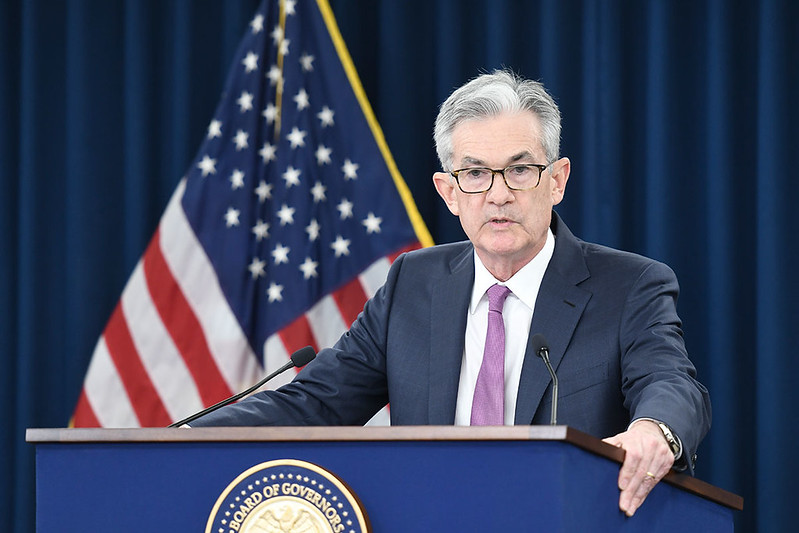
(Photo : Flickr)
US Federal Reserve chief Powell
- US consumer spending rose 0.5% in July, arguing against a significant Federal Reserve interest rate cut.
- Despite a rise in unemployment to 4.3%, Fed Chair Jerome Powell signaled a rate cut was imminent.
- The saving rate dropped to 2.9%, with economists divided on the implications of this decline.
- The impact of undocumented immigrants on the economy and global factors like OPEC+ oil supply also influence the economic outlook and potential for interest rate cuts.
The recent report from the Commerce Department indicates a solid increase in US consumer spending in July, suggesting that the economy remained on firmer ground early in the third quarter. This data argues against a half-percentage-point interest rate cut from the Federal Reserve next month. The report also showed prices rising moderately last month, curbing inflation.
Consumer spending, which accounts for more than two-thirds of US economic activity, rose 0.5% last month after advancing by an unrevised 0.3% in June. This increase was in line with economists' expectations. After adjusting for inflation, consumer spending gained 0.4% after rising 0.3% in June, implying that spending retained the momentum from the second quarter.
The increase in spending was across both goods and services, with outlays on motor vehicles and parts leading the charge. Consumers also spent more on housing and utilities, food and beverages, recreation services as well as financial services and insurance. They also boosted spending on healthcare, visited restaurants and bars, and stayed at hotels.
Unemployment and Inflation Concerns
However, the unemployment rate jumped to a near three-year high of 4.3% in July, stoking fears of a recession. This led financial markets and some economists to put a 50-basis-points rate reduction on the table when the US central bank embarks on a widely anticipated policy easing in September.
Despite these fears, Fed Chair Jerome Powell signaled that a rate cut was imminent, in a nod to the worries over the labor market. There is nothing here to push the Fed to a half-point cut, said Conrad DeQuadros, senior economic advisor at Brean Capital. This is not the kind of spending growth associated with recession.
The saving rate dropped to 2.9%, the lowest level since June 2022, from 3.1% in June. Economists were, however, not in agreement on the implications of the decline with some arguing that the government was not fully capturing income earned by undocumented immigrants. Others argued that households were drawing down on savings to maintain spending, which could imperil future consumption.
Impact of Undocumented Immigrants and Global Economy
Undocumented immigrants have also been cited as one of the factors behind the Labor Department's Bureau of Labor Statistics estimate last week that employment gains were overstated by 68,000 jobs per month in the 12 months through March. The so-called benchmark revision estimate is based on a data set derived from reports by employers to the state unemployment insurance programs. The data does not include undocumented immigrants, a group that economists believe contributed to strong job growth last year.
The BEA could be undercounting income earned by recent immigrants, whose economic activity is harder to measure than workers who have been in the U.S. longer, said Bill Adams, chief economist at Comerica Bank. That could mean the saving rate is higher than is currently reported, and would be revised higher when more accurate employment and earnings data become available.
In the context of the global economy, oil prices retreated as investors weighed expectations of a rise in OPEC+ supply starting in October, alongside dwindling hopes of a hefty US interest rate cut next month, following data showing strong consumer spending. Brent crude futures for October delivery settled $1.14 lower, marking a decline of 0.3% for the week and 2.4% for the month.
Otherwise, the US economy appears to be on a steady path, with solid consumer spending and moderate inflation. While the unemployment rate has risen, the overall economic indicators suggest that a significant interest rate cut by the Federal Reserve may not be necessary.
The impact of undocumented immigrants on the economy is also a factor to consider, as their economic activity could potentially be undercounted, leading to a higher actual saving rate. The global economic context, particularly the expected rise in OPEC+ oil supply and the strong US consumer spending data, also plays a role in shaping the economic outlook and the potential for interest rate cuts.









